Abstract
The article discusses the methods and tools for assessing the socio-economic development of territories, reflecting social and economic progress and requiring economic growth. Growth is a vital and necessary condition for development, but it is not sufficient one, because it cannot guarantee development. The degree of socio-economic development of countries includes considering a number of narrow and broad indicators, including per capita income, life expectancy, education, unemployment, and poverty. In turn, the development is the creation of conditions for self-realization of people and the elimination of obstacles to freedom. Freedom let people choose their own destiny. However, on the path to freedom and, consequently, to development, obstacles arise, such as poverty, lack of economic opportunities, corruption, poor governance, lack of education and inadequate public health. The article presents a congruence of socio-economic indicators of the development of the Caspian countries over the past ten years, conducted a comparative analysis and identified priorities for the development of territories. The signing of the Convention on the legal status of the Caspian Sea requires compliance with agreements, which can only be achieved at a certain level of economic development and legislation of the Caspian countries. The identified trends in population size, employment levels, unemployment, poverty, corruption perceptions and global competitiveness indexes, as well as education and health costs have led to the conclusion that national economies are similar in development, which allow forming the basis for strict adherence to established agreements.
Keywords: Unemploymentcorruption perception indexglobal competitiveness
Introduction
The five powers are part of the Caspian countries - these are: Azerbaijan, Iran, Kazakhstan, Russia and Turkmenistan. It unites their access to the Caspian Sea, the largest inland lake in the world with an area of 371,000 square km and ocean type bed, which is an object of legal requirements and a source of substantial replenishment of national budgets of these countries. The Caspian Sea is a unique source of hydrocarbon and biological resources, logistic transit and home of commercial and military fleets. Thus, the proven oil resources make up 4% of world oil reserves, and its potential is at 40 billion tons and 8.76 trillion cubic meters of gas (the potential of hydrocarbon resources puts the Caspian region in second place in the world after the Persian Gulf in terms of oil and gas reserves); biological resources have more than one and a half thousand species of fish and mammals, among which sturgeon occupies a special place (the catches of which make up to 80% of the total world catch). Socio-economic trends in the development of these territories have a significant impact on neighboring countries and the world community as a whole.
Problem Statement
In August 2018, the leaders of the Caspian states signed the Convention on the legal status of the Caspian Sea. According to it, the 15 nautical miles adjacent to the coast of each country are their territorial waters, to which another 10-mile exclusive fishing zone adjoins. This Convention makes the countries of the Caspian region unique carriers of competitive advantages. At the same time, in order to maintain the agreements reached, the five of these countries must take into account the general principles of development of the Caspian region and the direction of development of national economies. To determine the existing levels of development of the Caspian countries, this article conducted a country comparison of socio-economic indicators of their development.
Figure
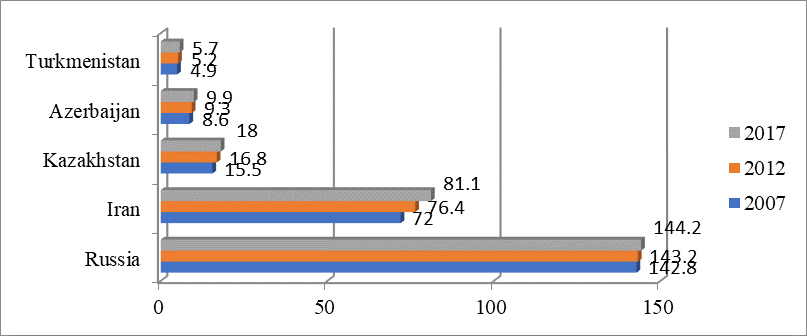
Further, there are each of the presented socio-economic and legislative parameters of development of the Caspian countries for the last 9 years.
Research Questions
The subject of the research is the instrumental means (forms, methods and ways) of assessing the socio-economic trend of the development of territories, as well as tools and technologies that ensure the steady growth of the analysed countries.
Purpose of the Study
The aim of the study is to form a conceptual model for assessing the socio-economic development of individual countries in the context of modern transformations and improving the legal framework, taking into account the general trend of world development, the adaptation of economic instruments and the mechanism of managing the process of ensuring sustainable growth to create a socially favourable environment by integrating and combining approaches, tools and technologies for making effective managerial solutions.
Research Methods
To achieve this goal, empirical methods of examination, statistical induction, analysis of variance using quantitative statistical tools (percentage, average values, heteroscedasticity, etc.) were used. The instrumental and methodological apparatus of the research includes the principles of the system-functional approach to the analysis of phenomena developed by Russian and foreign scientists, as well as private methodological tools for economic development: economic and statistical groupings (structural, illustrative, typological), methods of economic and mathematical modeling, program-forecasting and analytical design, index estimates, time series analysis, graphical interpretations, etc.
The assessment of the main trends in the economic development of the countries of the Caspian region was carried out through the analysis of selected statistical characteristics, using point and interval estimates and methods of mathematical statistics (analysis of variance). The result of the analysis of the selected statistical characteristics is a point estimate of the average value and variance of the global competitiveness index and the perception of corruption in the Caspian countries.
Findings
To determine the level of development of health care, we use the worldwide indicator of health care expenditures in the form of their share of the country's GDP. As we can from Figure
At the same time, life expectancy in the Caspian countries is 71.6 years in Russia, 76 years in Iran, 72 years in Azerbaijan, 72.3 years in Kazakhstan, and 67.8% in Turkmenistan. According to the above data, we can point that there is no direct connection between the level of expenditures on health care and the life expectancy of the population.
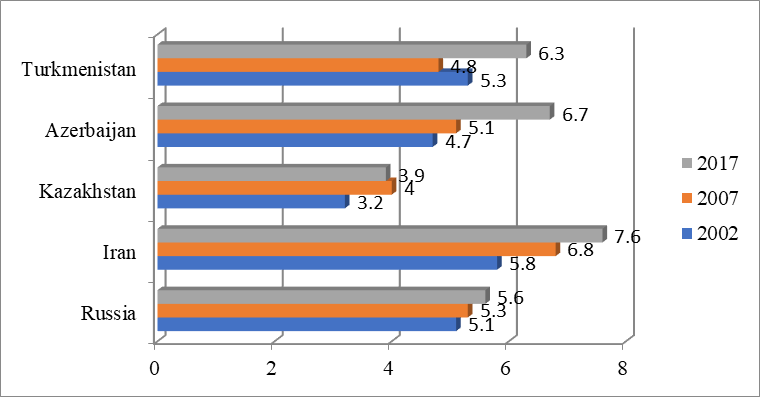
Another no less important indicator of the development of modern society is government expenditure on education as a percentage of GDP. There are no data for Turkmenistan for 2007 and 2015, for Russia are according to the data of the Federal budget for 2014-2016 years on the section "Education" (Brylyakova, 2014).
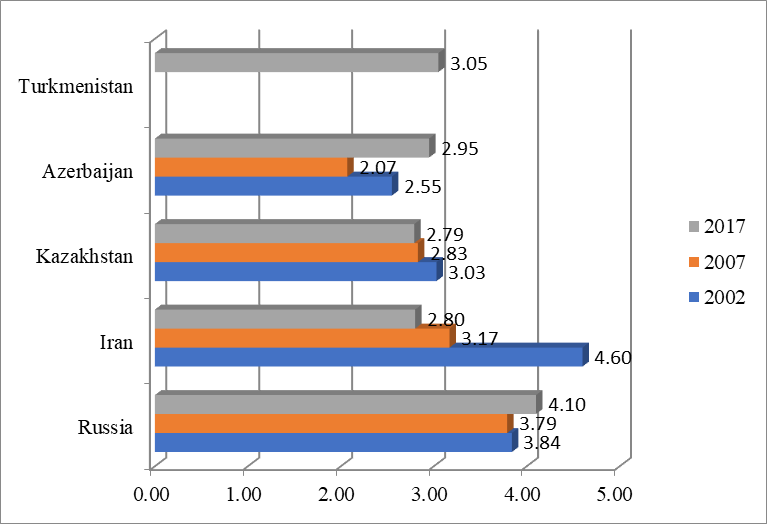
The average expenditures on education in the Caspian countries is 3.5%. The largest expenditures are in Russia, the lowest in Turkmenistan (Figure
The human development index is an average achievement in three main dimensions of human development - health, education and a decent standard of living. The closer the index is to one, the more developed the country is (Mineva, Kashirskaya, & Minev, 2019).
We divided countries into four categories: 0.955 to 0.805 – a very high level of human development; 0.796-0.712 – a high level of human development; 0.71-0.536 – the average level of human development; below 0.534 – a low level of human development (Sakharova, 2014).
Among Caspian countries, only Russia belongs to countries with a very high level of human development. The rest of the countries can refer to countries with a medium level of human development (Figure
Based on this information, we can conclude that the countries in question are approximately at a general level of development.
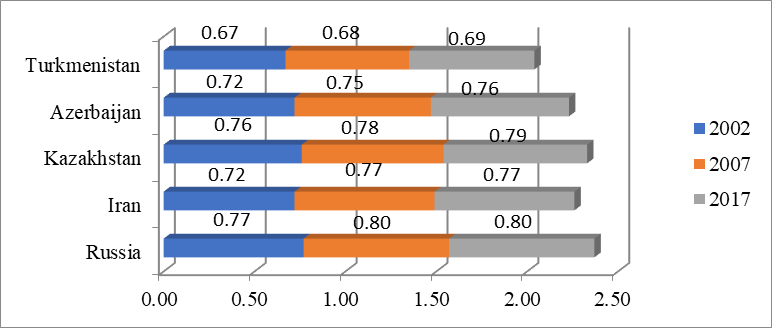
Further, in a comparative analysis of the socio-economic indicators of the development of the Caspian countries, we consider the indicators of employment, unemployment and the level of poverty.
As we known, the employment level is determined by a coefficient reflecting the share of the employed population among the share of persons over 15 years of age. This indicator affects the national unemployment rate, mediated by a reduction in wages and an increase in the level of poverty (Figure
In the article of Beksultanova (2017) the conclusion is “The current labor market in Russia is characterized by a fairly high unemployment rate and at the same time there is lack of qualified personnel”, which we cannot agree with, since it goes against the available statistics and global trends.
We completely agree with the opinion that in the modern world the state acts as a regulator of relations in the field of labor. Consequently, the Caspian countries should be more active in the field of state guarantees of employment (Agigullina, 2016).
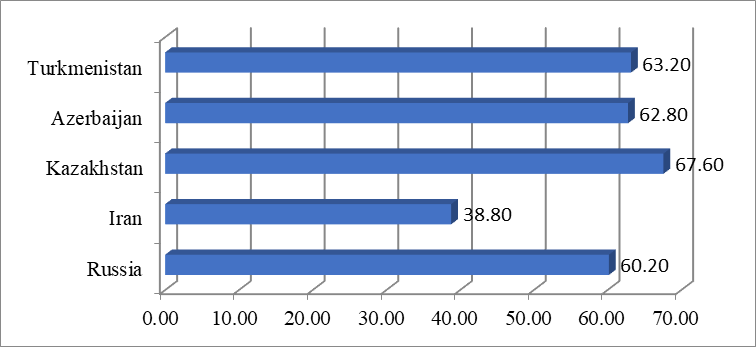
The world unemployment rate in 2017 was 5.8%, in developed countries - 6.2%, in emerging market countries - 5.7%, in developing countries - 5.5% (Zaitseva, 2017). According to statistics from the Caspian countries over the past decade, unemployment has been falling (Figure
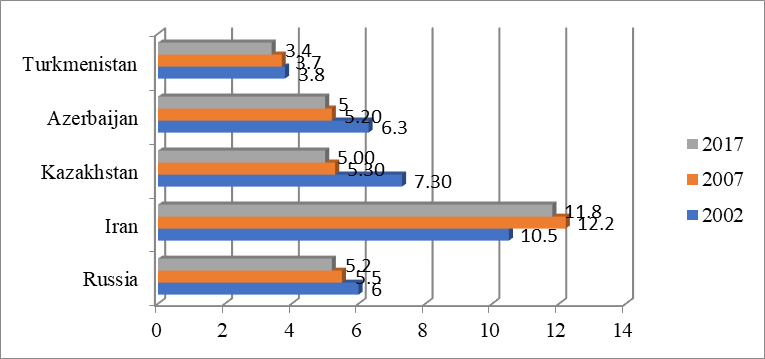
Next to this indicator, the poverty indicator is closely adjacent. The poverty level according to the World Bank methodology assumes accounting for the proportion of the population with an income below $ 1.9 per day, calculated at international prices. According to the World atlas of data, the latest official poverty data for Turkmenistan refer to 1998 and amounted to 51.4%. For Russia, Azerbaijan, Kazakhstan, this figure is zero percent. In Iran, it is equal to 0.2%. The lack of data for Turkmenistan does not allow us carrying out a full analysis of this indicator.
It is interesting to study two indices - the index of global competitiveness and the index of perception of corruption. In addition to the indicators discussed above, these indicators form a perception of the expectations of the business world and potential investors from entering national markets.
The global competitiveness index was developed by experts of the World Economic Forum and includes indicators of nine basic support groups: institutional environment, infrastructure condition, macroeconomic indicators, development of health care and primary education, higher education and vocational training, market efficiency, technological sensitivity, business organization and innovation (Rogatnykh, 2006).
The global competitiveness index in 2017 for 137 countries of the world shows that the highest index belongs to Switzerland – 5.9 points; the USA – 5.9 points; the lowest Yemen – 2.9 points.
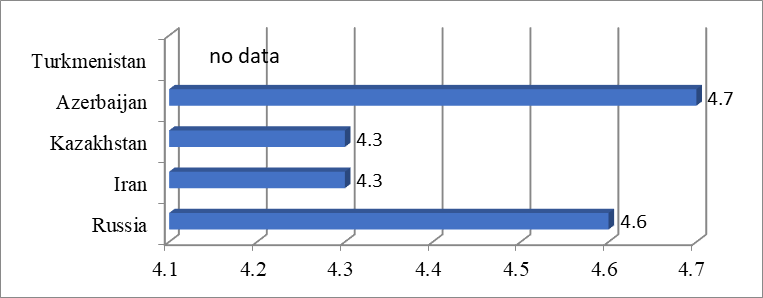
Russia and Azerbaijan are among the top ten countries, and Iran and Kazakhstan are higher than the middle of the rating (Figure
The corruption perception index is a cumulative indicator that reflects all actions, including minor ones, which can be regarded as corruption violations. Based on the information, countries are ranked on a scale from 0 to 100. In this ranking, countries with a high level of corruption are set at “0”, with weak corruption at “100”.
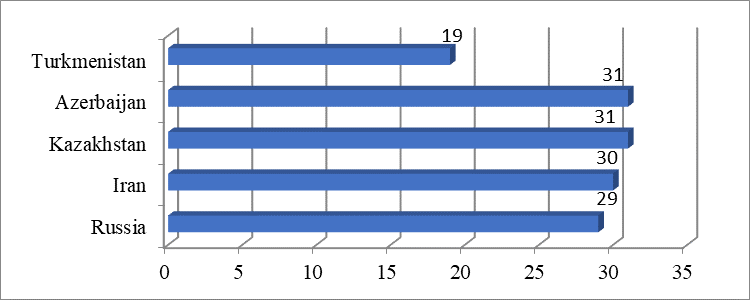
According to Transparency International, bribery is a phenomenon that is to some extent common in all national economies of the world. More than two thirds of the countries included in the study of this organization received less than 50 points, their average score was 43 points. The data presented in Figure
Conclusion
Summarizing the trends in the economic development of the Caspian countries, we can conclude that they are similar, including the strengthening of anti-corruption legislation, which should contribute to the implementation of the Convention on the legal status of the Caspian Sea in full.
References
- Agigullina, G. R. (2016). Employment of the population as an economic category. Bulletin of the Ulyanovsk State Technical University, 3, 74.
- Beksultanova, A. I. (2017). The problem of employment in the Russian Federation. European research, 5(28), 38.
- Brylyakova, M. P. (2014). Budget 2014-2016: financing of the national education system. Accreditation in education, 4, 32.
- Mineva, O. K., Kashirskaya, L. V., & Minev, V. S. (2019). Country comparison of the main socio-economic indicators of the development of the Caspian countries. Economics and management: problems, solutions, 1(2), 142–148.
- Rogatnykh, Е. (2006). Global Competitiveness Index: Issues of the Methodology of Construction and Evaluation. World Economy, 12, 13.
- Sakharova, O. N. (2014). Human Development Index: Russia's place in the modern world. Bulletin of the Taganrog Institute of Economics and Management, 1, 16–17.
- Zaitseva, I. A. (2017). Unemployment as one of the global problems of the modern world. PolitBooke, 2, 164.
Copyright information

This work is licensed under a Creative Commons Attribution-NonCommercial-NoDerivatives 4.0 International License.
About this article
Publication Date
28 December 2019
Article Doi
eBook ISBN
978-1-80296-075-4
Publisher
Future Academy
Volume
76
Print ISBN (optional)
-
Edition Number
1st Edition
Pages
1-3763
Subjects
Sociolinguistics, linguistics, semantics, discourse analysis, science, technology, society
Cite this article as:
Alikhanova, L., Markelov, K., Prigoda, L., Mineva*, O., & Alikaeva, M. (2019). Congruence Of The Rating Trends Of Economic Development Of The Caspian Countries. In D. Karim-Sultanovich Bataev, S. Aidievich Gapurov, A. Dogievich Osmaev, V. Khumaidovich Akaev, L. Musaevna Idigova, M. Rukmanovich Ovhadov, A. Ruslanovich Salgiriev, & M. Muslamovna Betilmerzaeva (Eds.), Social and Cultural Transformations in the Context of Modern Globalism, vol 76. European Proceedings of Social and Behavioural Sciences (pp. 2291-2298). Future Academy. https://doi.org/10.15405/epsbs.2019.12.04.305
